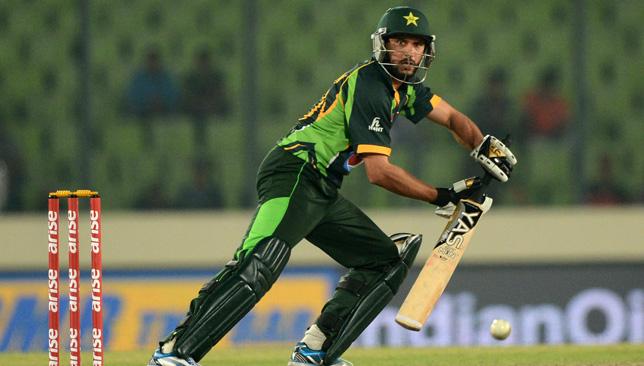
According to Pakistan all-rounder Shahid Afridi, cutting out the crowd noise is the best way to avoid any distraction while batting. And the way to do it by using earplugs.
The hard-hitting batsman came up with the novel idea during the one-day series against New Zealand as he looked to regain some batting form ahead of the World Cup. And it worked wonders with the 34-year-old scoring 205 runs from five innings at an average of 41, with two half-centuries, to go with the eight wickets he picked up at an economy of 4.03.
– #Quiz360: WIN dinner for 2 at Channels, Media Rotana, Dubai
– #360Awards: VOTE for your sportsmen, sportswomen & teams of 2014
– #360debate: Should Pietersen be brought back into the England set-up?
Earplugs seem a simple enough apparatus to ensure the batsman concentrates on the hitting the ball but it surely must make run-outs that much easier to affect as calling between the batsmen is down to zero. But Afridi made it work and it’s another addition to the quirky list of aids or augmented apparatus, that are or were within the rules of the game, players have used over the years to improve their performance.
The first instance that comes to mind is Australia wicketkeeper Adam Gilchrist and the squash ball. In the final of the 2007 World Cup, Gilchrist played one of the most stunning ODI innings against Sri Lanka to snatch the third straight 50-over world title for the Aussies. His 149 off just 104 was a breathtaking display of power hitting, an effort aided by squash ball in his bottom (left) hand that enabled him to grip the bat better. It worked for him brilliantly in the final but hasn’t been used by others as it’s just too radical an approach.

Afridi’s unique earpiece wasn’t the first to be used on the cricket field. If the Pakistani used his to keep his head clear of any outside noise, South Africa utilised theirs to keep the captain connected with the coach. At the 1999 World Cup, the Proteas took on India in a crucial match and coach Bob Woolmer thought the best way to keep skipper Hansie Cronje one step ahead of the game was by giving him real time inputs from the dressing room.
So when the South Africans took the field, Cronje and pacer Alan Donald went in wired up. It was only when India batsman Sourav Ganguly saw Cronje seemingly talking to himself that he alerted the umpires about it, who spoke to the match official and after consultation with the ICC, the decision was made that no rule had been broken but since it was deemed an unfair tactic, the Proteas were asked to do away with it. It was, however, not an illegal aid. Two other instances show how players are ready to try something new to become better.
Sri Lanka batsman Russel Arnold was the first international cricketer to use the ‘Wand Bat’, which had the edge near the top of the bat shaved off. The idea behind that was that since that part of the blade only results in edges going to the keeper or slip, removing them would only lessen the chances of nicking it without affecting scoring.
Australian opening batsman Matthew Hayden went one step ahead and unveiled the Mongoose bat, which was basically half the length of a normal bat with an elongated handle and with the sole purpose of hitting the ball out of the park.
There has been innovation in wicketkeeping as well. India gloveman Dinesh Karthik has used a baseball-style helmet while keeping in the Indian Premier League on numerous occasions. The reason is that since cricket helmets somehow allow the ball to push its way in, a cushioned helmet like the one baseball players use is best suited while standing up to the keeper as the ball just bounces off the grille. How long before a version of that is used by batsmen so that tragic incidents that which took the life of Phillip Hughes never happen again?

Interestingly, we haven’t seen such innovation in bowling. The one aspect that I feel needs immediate addressing is bowlers with dodgy actions. Thankfully, the ICC too is thinking on the same lines. They are hoping to use wearable sensors sometime in the near future to check bowlers’ action in real time. That little gadget will solve so many issues plaguing the system, and also ensure there is no ambiguity or secrecy regarding the legality of a particular bowler’s action. Players will have to bowl without flexing their arm beyond the specified limit and the job of the umpires and match referees will become that much easier.
Coming back to Afridi, it’s strange that he hit upon the earplugs idea 18 years after making his debut, having played in front of a 100,000 spectators in Kolkata. But at least he is trying something new. And it’s thankfully not as atrocious an idea as Dennis Lillee’s aluminium bat in the 1979 Perth Test against England. The ‘Combat’ created such an ugly sound when ball hit bat, the Australian pacer was asked to revert to a wooden bat and a few months later, the laws were amended to specify that bats should be made of wood.
The above mentioned ideas worked to a certain degree. But it’s that endeavour to improve that pleases the most. So in the pursuit of excellence, keep innovating guys.